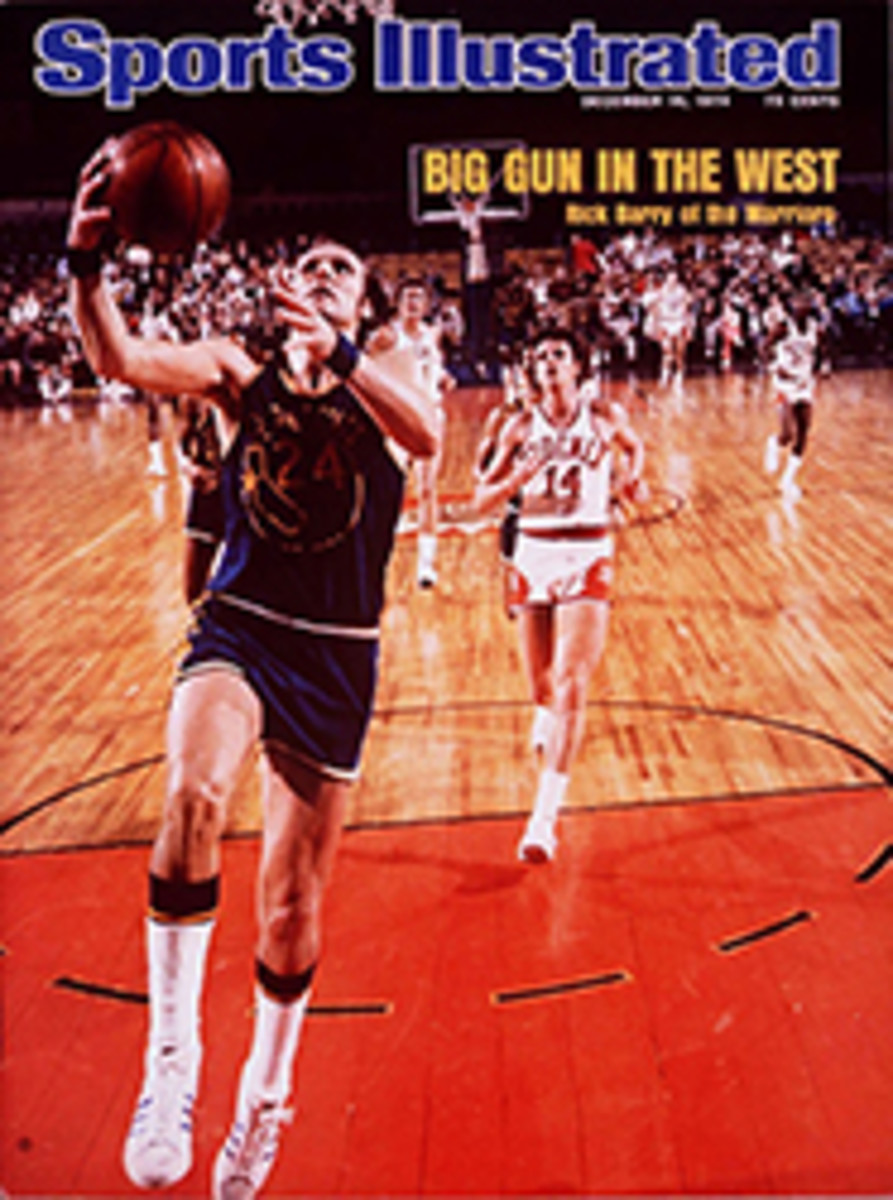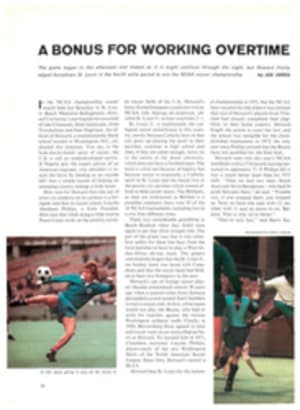
SCORECARD
DOUBLE CROSS COUNTRY
The 1974 NCAA cross-country championships at Bloomington, Ind. will be remembered, if at all, for the runners who did not compete. Ohio State refused to send Tom Bryant, who finished fifth in the Big Ten meet and conceivably could have made All-America by finishing among the first 25 in the nationals, and Tom Byers, a good bet to make the Olympic team in the 1,500 meters. Fordham refused to send an entire team, although the Rams had the talent to finish respectably in the standings.
Various rationales were offered, but they can be reduced to two words, money and lose. The schools were not going to foot the bills for runners who were not quite good enough to win. That is sport?
THE CRITIC
The cover was missing, pages were shredded and there were teeth marks and claw prints on what remained of a book returned to the library at Linn-Benton Community College in Oregon. The book's title: How to Keep Your Pet Healthy. Hard to tell whether the beast liked it or hated it.
BANNING DRUNKEN DIVING
It is one more strand of red tape, which pleases nobody, but with so many deaths from drowning—some 125-150 each year in U.S. waters—the Los Angeles County Board of Supervisors passed a law this fall requiring that scuba divers be licensed. The board, which estimates that a fourth of all U.S. divers live in Southern California, also made physical checkups and license renewals mandatory every two years and, probably most important of all, made it illegal to dive within 24 hours of taking a drink containing alcohol. Many of the deaths have been attributed to diving after drinking.
"Divers are afraid the regulation will hurt the sport," said Lloyd Bridges, who starred in the TV show Sea Hunt, "but it is a law long overdue. It's a whole different environment out there in the ocean. It takes getting used to—by stages—and drinking is just asking for trouble. Alcohol affects the brain to a much greater degree in the pressure under water. People who can handle a drink or two on the surface find themselves in life and death situations 30 feet below the surface."
WAY TO GO, DADS
Secretariat and Riva Ridge are champions after all. The problems they were supposed to be having as nascent sires can be traced to the strict technical language of the syndication agreements and not to sterility. Secretariat succeeded in impregnating 34 of 36 mares, Riva Ridge 27 of 33, impressive records for rookie stallions. Ordinarily, 75% success is considered good. If their get are anywhere near as proficient, sibling rivalry will be rampant at the 1978 Kentucky Derby.
FORMULA TO END A FRIENDSHIP
What began as a cooperative effort between the Sports Car Club of America and the United States Auto Club became so successful in its first year that—what else?—the two may not be cooperating again in 1975.
To keep car owners happy, and solvent, the two organizations co-sanctioned a professional Formula 5000 series this year in which the qualified cars cost considerably less to campaign than a USAC Championship Trail car or an SCCA Can-Am prototype. The series took off, and with Mario Andretti locked in a battle for the championship right down to the final race, promoters were able even to make some bank deposits in what was otherwise a lean year. In fact, the Formula 5000 did so well for the SCCA that the club abandoned its two other professional race series, canceling the Can-Am entirely and surrendering the Trans-Am to the fledgling International Motor Sports Association.
But then the SCCA's 1975 schedule was announced. The strongest reference to co-sanction was that "talks were in progress." Back in Indiana USAC seemed to be wavering. In exchange for lending the series its publicity-generating drivers, all it got in return was an increase in the number of demands that it do something to cut the costs of Indy car racing, plus a little money.
If the USAC-SCCA cooperation collapses (the USAC claims it will not), that is about it for Formula 5000, and possibly for SCCA as a force in professional racing. Its driver roster is barren of promotable names. Little wonder that racing millionaire Richard Petty sticks almost exclusively with NASCAR.
NEVER TOO LATE
When he was in his 90s, Canadian golfer C. Arthur Thompson consistently scored under his age. He is 105 now and the recipient last month of one new honor, this one from the Uplands Golf Club of Victoria. A life membership.
HOT WORDS, COOL RECEPTION
Back in the locker room for prayers and inspiration before the season final against Pittsburgh, Penn State got carried away—at least Greg Buttle did.
First, Mike Hartenstine, the quiet Lion, spoke. Then Tom Donchez took over, and the sparks flew. He reminded the squad of its responsibilities, he told it what a victory would mean, he warned how devastating a defeat would be. He became so worked up that words suddenly failed him. Donchez hurled his helmet against a locker. It bounced back and hit Buttle straight between the eyes, knocking him cold.
"Oh, God," said Coach Joe Paterno, "can't we even get through the team prayer without an injury?"
WHEELS THAT TAKE WING
Of all forms of transportation ever devised, there are few, apparently, as inefficient as the bicycle. The condition will not last much longer, though, say some inventor-designers who have been experimenting with vehicles that resemble variously a floating egg with human legs attached, a knight on his horse in full skirt and that old cheese box, the Monitor.
What each of these models is trying to get around is the drag that rider and bicycle create. Because neither is streamlined, they force air molecules to curve sharply around them in front and they pull swirling, thrashing cyclones of air along in back. Jack Lambie, a consultant to a California firm that is experimenting with truck shapes, estimates that on a 100-mile ride the average bicyclist pushes aside almost 10 tons of air. Any rider able to maintain 30 mph for the distance—the best achieve that rate only in spurts—would expend 92% of his energy moving molecules. Lambie has designed a shell to cover bike and rider that reaches to within six inches of the ground, reduces drag by 27% and has been tested at 35 mph.
Chester Kyle, a professor of mechanical engineering, has his Teledyne Titan. It too is fitted with a shell, aluminum, that encloses man and machine. Test ridden in a hallway a furlong long, it achieved a reduction of 60% drag. Rider Ron Skarin has reached over 40 mph on the Titan. Kyle, Lambie and several others will get together this spring for a race that most likely will qualify for some sort of world record. Eventually, Lambie predicts, somebody will do 100 on a bike. With a patrol car right behind, no doubt.
TIME FOR REFORM
Legal maneuvering on both sides has postponed for a while, perhaps indefinitely, the showdown between Frank (Pancho) Martin and New York State Racing Association stewards. The leading trainer in the state, Martin had been suspended for 60 days on charges that he ran two horses whose postrace tests came back positive.
The case has its disturbing aspects. For one, the stewards appeared to be picking on Martin, a wheeler-dealer from Cuba who claims a lot of horses, some of them owned by friends of the Establishment that controls New York racing. Last summer two old friends of the powers that be, Allen Jerkens and Tommy Root, ran horses that came back positive, too, but rather than ban the two trainers the stewards called in the FBI and a frantic search was undertaken in the stable area at Belmont to nail mysterious outsiders who were shooting up the horses. None was found.
The fact is, everybody in racing knows that it is impossible to keep horses in training over today's long seasons without using all kinds of medicine to alleviate bleeding, soreness, inflammation and various other infirmities to which racehorses are prone. But the very word "drug" has an offensive ring. So the tracks go on testing for medications that generally have no effect on a horse's speed, and trainers have a Damocles' sword hanging over their heads. They have to use medicines to stay in business, the medicines have to be out of the horses' systems by post time and nobody can say how long that will take, each horse's metabolism being different.
Justice should be evenhanded, and it can be only if there are uniform rules and standards, for both men and drugs. Martin may not be loved, but he has a just claim in the game.
WHAT'S IN THE NAME? NOTHING
The St. Louis Globe-Democrat headline Said, TAYLOR BOXES STIFF ON AMATEUR CARD. That was Sam Taylor against Benjamin Stiff. Taylor turned out to be the stiff.
BASTILLE DAYS
Ugly doings among the lily pads. The bass are all right. They just go about their business, stealing lures and wrapping lines around sunken logs and old Franklin stoves. It's the fishermen. Nobody but nobody is trusting anyone these days.
First there was the $18,000 bass-fishing tournament last May in Florida. The publisher, vice-president and field editor of American Bass Fish Magazine have been charged with rigging it by catching a mess of bass the week before the contest, storing the fish in tanks and then giving them to unindicted co-conspirators to present to contest judges as legitimate catches. Allegedly, the anglers with an angle turned over half their winnings to the accused, who last week denied everything.
The organizers of another big Florida bass bash, something called the $100,000 World Championship of Bass Fishing held several weeks ago near Lake Whales, were taking no chances. They laid on a lie detector test, an X-ray machine to check the largest bass for lead pellets or other weight-inducing additives and tranquilizers to keep the bass quiet while being weighed. Still they got snookered.
In a classic case of "local knowledge," Jim Melvin of St. Petersburg and Larry Singleton of Tampa labored for two days before the tournament clearing a hyacinth-clogged canal into a lake. They gambled that by the time their secret fishing hole had been discovered they would be home rich. How right they were. Melvin, quite legally, won $20,000 for his catch—the limit of 20 bass, weighing in at 44 pounds, 11 ounces. Singleton, within the law, too, picked up $10,000 as runner-up with a total eight pounds lighter. The money, they said, beat the going two-day rate for canal clearing.
The lie detector test? The top 10 producers, who reeled in $65,000 collectively, sailed through polygrapher Ben Bennet's searching questions without a flicker. But the X-ray machine never arrived and the plan to tranquilize the fish was aborted when all 1,000 or so were brought in at the same time. Most of the bass were released, presumably to test fishermen—and liars—another day.
ILLUSTRATION
THEY SAID IT
•Jack Mildren, New England defensive back, on his familiarity with the offensive tendencies of his old team, the Colts: "They know I know and I know they know I know, but I don't know how much I know."
•Dennis Awtrey, Phoenix Suns center, glancing at a box score that showed him 0 for 7 from the floor: "I wasn't aware I had a perfect night."
•Remsen Becker, Newark College of Engineering basketball coach, discussing his team: "I've been waiting for three years to lose some players. I'm happy to report this year we have only three lettermen returning."

